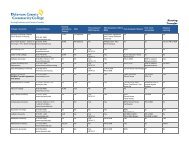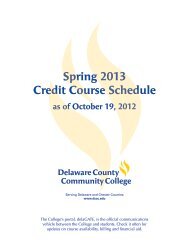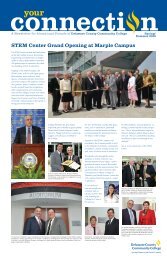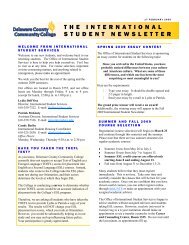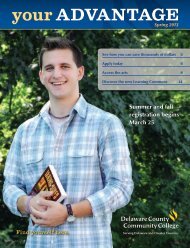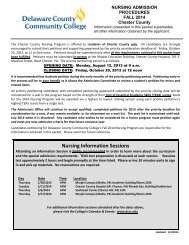2010 Catalog - Delaware County Community College
2010 Catalog - Delaware County Community College
2010 Catalog - Delaware County Community College
Create successful ePaper yourself
Turn your PDF publications into a flip-book with our unique Google optimized e-Paper software.
COURSE DESCRIPTIONS 107<br />
addition to general lighting needs.<br />
• Re-cable an upgraded kitchen from Rip-out to Reinstallation.<br />
This will require calculating circuit loads, determining<br />
cable types and sizes and over-current devices.<br />
• Determine the maximum number of conductors permitted<br />
in a given size electrical box in accordance with<br />
de-rating factors.<br />
• Understand the difference between grounded and<br />
ungrounded conductors.<br />
• State the difference between the terms ground, grounding<br />
and bonding.<br />
• Understand NEC requirements; where and how GFCI and<br />
AFCI circuits are installed.<br />
• Define the terms electrical service, overhead services,<br />
service drop and service lateral.<br />
• Describe how to determine the electric service<br />
requirements based on the calculated load for a dwelling.<br />
• Identify and apply electrical materials and how they<br />
are used.<br />
• Prepare residential drawings as per NEC and standard<br />
wiring practices.<br />
• Describe the different types of non-metallic and metallic<br />
boxes and determine where and how used.<br />
• Describe outdoor residential wiring applications, when<br />
and how to use PVC conduit, underground cable, waterproofing<br />
wiring functions, etc.<br />
• Demonstrate an understanding of the general<br />
requirements for wiring as they apply to residential<br />
rough-in wiring.<br />
Prereq. ELT 104<br />
4 Credits 3 Weekly Lecture Hours<br />
2 Weekly Laboratory Hours<br />
ELT 102<br />
Commercial Wire I<br />
Commercial Wiring I presents the requirements of a<br />
commercial electrical installation. Specific commercial<br />
installation methods, techniques, materials and National<br />
Electrical Code requirements will be presented.<br />
Upon successful completion of this course, students<br />
should be able to:<br />
• Define job requirements from the contract documents.<br />
• Identify and properly apply different wiring devices.<br />
• Size and apply various types of conduits.<br />
• Install electrical boxes.<br />
• Size and install branch circuits per National Electrical<br />
code requirements.<br />
• Demonstrate a working knowledge of special raceways,<br />
outlets and communication systems.<br />
• Read engineering drawings.<br />
• Properly apply National Electrical Code requirements to<br />
the intended use presented by engineering drawings.<br />
• Describe the different types of lighting systems and<br />
associated fixtures.<br />
Prereq. ELT 101<br />
4 Credits 3 Weekly Lecture Hours<br />
2 Weekly Laboratory Hours<br />
ELT 104 Introduction to Electricity<br />
Special studies<br />
Introduction to Electricity will equip students with the<br />
fundamental skills essential to perform in the various fields<br />
of electricity. This course of study emphasizes safe working<br />
procedures in a construction environment and the proper<br />
installation methods of materials in accordance with the<br />
National Electrical Code (NEC). Students will learn how<br />
voltage current and resistance are related to each other and<br />
to calculate electrical solutions to determine unknown values<br />
using Ohm’s Law formulas. Students will learn methods,<br />
materials, electrical connections, cable types, sizes and<br />
current capacity of conductors; followed by methods of<br />
installation of lighting, receptacles, and switching circuits<br />
used in a residence.<br />
Upon successful completion of this course, students<br />
should be able to:<br />
• Interpret electrical drawings including site plans, floor<br />
plans, and detail drawings.<br />
• Identify the types of lines and symbols used on blue prints.<br />
• Apply safe electrical practices and the basic safety rules<br />
for working on electrical systems.<br />
• Calculate the potential, current, and resistance of an<br />
electrical circuit using Ohm’s law.<br />
• Describe and install the different types of electrical<br />
outlets, boxes, switches, and other basic electrical<br />
materials used in electrical installations.<br />
• Demonstrate an understanding of the proper installation<br />
techniques for single-pole, three-way, four-way, doublepole<br />
switches and split receptacles.<br />
• Select the proper code requirements for calculating branch<br />
circuit sizing and loading.<br />
• Understand the basics of typical family dwelling heating<br />
and air conditioning system and associated major<br />
components and to interpret related schematic<br />
wiring diagrams.<br />
• Calculate ‘volt-amperes per foot’ for calculating general<br />
lighting loads.<br />
• Specify and apply over-current protection devices for<br />
conductors and the maximum loading on branch circuits.<br />
• Interpret electrical plans to determine special installation<br />
and wire connection requirements for major residential<br />
appliances.<br />
• Understand the terminology used when discussing<br />
grounding and bonding requirements.<br />
• Compute electrical loads and select proper conductor<br />
sizes and over-current devices for dedicated circuits in<br />
compliance with NEC.<br />
• Explain the difference between conductors and insulators.<br />
• Install typical residential low-voltage lighting, telephone<br />
and television CATV wiring in conformance with NEC.<br />
• Demonstrate an understanding of the shock hazard<br />
associated with electrical work.<br />
Prerequisite: None<br />
4 credit hours 2 Weekly Lecture Hours<br />
3 Weekly Laboratory Hours<br />
ELT 152<br />
Electrical Code, Special studies<br />
This course will acquaint the students with the many<br />
aspects of the National Electrical Code. The National Electrical<br />
Code is the basic code that governs all electrical installations.<br />
The course will offer the student the opportunity of<br />
learning proper application of the code to all facets of<br />
the electrical installation.<br />
Upon successful completion of this course, students<br />
should be able to:<br />
• Apply the National Electrical Code index in referencing<br />
a question.<br />
• Cite a proper interpretation as to the intent of the<br />
National Electrical Code.<br />
• Identify tables applicable to various situations.<br />
• Cite the evolution of the National Electrical Code.<br />
• Identify and apply proper over current protection devices<br />
for a circuit in accord with the Code.<br />
• Apply minimum Code requirements to a floor plan of a<br />
residence, relating outlet locations, and minimum service<br />
entrance size and number of circuits required.<br />
2 Credits 2 Weekly Lecture Hours<br />
ELT 202<br />
Industrial Electric II<br />
This course will include heavy coverage in the areas of<br />
transformer selection and installation, AC circuits, AC motor<br />
control, industrial lighting and electric heat.<br />
Upon successful completion of this course, students<br />
should be able to:<br />
• Describe the effect of high- and low-power factors on<br />
alternating current circuits.<br />
• Cite the methods for producing single and multi<br />
phase voltages.<br />
• State the construction and operating characteristics of<br />
transformers, illustrating the various types of transformer<br />
connections and discussing the results of these connections.<br />
• Detail the construction of various AC motors.<br />
• Demonstrate a knowledge of the construction and<br />
operation of various types of motorcontrollers and<br />
protective devices.<br />
• Determine the amount of light required for various areas<br />
and types of work.<br />
• Lay out and select the correct lighting fixtures for<br />
various areas.<br />
• Explain the operation of electronic motor controls.<br />
Prereq. ELT 201<br />
4 Credits 3 Weekly Lecture Hours<br />
2 Weekly Laboratory Hours<br />
ELT 203<br />
Industrial Electrical Systems<br />
This course provides the student with an introduction to<br />
various electrical systems and devicesused in a<br />
manufacturing/commercial facilities environment. Students<br />
will learn how to identify the function of electrical components,<br />
to include relays, sensors, switching/other devices and<br />
circuits. Instruction will include the theory and use of<br />
electrical instruments, to install and make repairs as well<br />
as identify, troubleshoot isolate and remedy problems.<br />
Emphasis will be placed on electric motors and motor<br />
controls. Topics of instruction will cover installation of<br />
electrical conduit, wiring, motors and other devices.<br />
Upon successful completion of this course, the student<br />
should be able to:<br />
• Define the terminology associated with common/basic<br />
electrical systems and devices.<br />
• Describe the operational characteristics and applications<br />
of various sensing devices.-<br />
• Identify and describe the function of basic control<br />
circuits/components.<br />
• Contrast electrical starting and braking methods.<br />
• Compare wound rotor, synchronous and consequent<br />
pole motors.<br />
• Conduct job planning routines for various electrical<br />
component and system<br />
installations/repairs/replacements.<br />
• Determine sizes and install electrical conduit, boxes,<br />
wiring, etc. with regard for engineered work plans and<br />
appropriate standards.<br />
• Install motor controls and motors.<br />
• Discuss and troubleshoot sensing devices and circuits, to<br />
include ground faults.<br />
• Determine a methodology for troubleshooting various<br />
distribution and control circuits. Troubleshoot variable<br />
frequency AC motor drives.<br />
Prereq. TCC 111, TEL 101, IST 105<br />
4 Credits 3 Weekly Lecture Hours<br />
2 Weekly Laboratory Hours<br />
ELT 204 Introduction to<br />
Programmable Logic Controllers<br />
This introductory course is intended to acquaint students<br />
in a hands-on mode with the basic skills and knowledge of<br />
programmable logic controllers, with respect to Industrial<br />
Systems. Students will learn to interpret electrical and<br />
Programmable Logic Controller (PLC) input/output diagrams<br />
and ladder logic. In addition, they will become acquainted<br />
with PLC functions, components, circuitry, testing of PLC<br />
programs and troubleshooting a PLC system. This course is<br />
recommended for students with little or no programmable<br />
logic controller experience. Upon successful completion of<br />
this course, students should be able to:<br />
• Discuss terminology associated with PLCs.<br />
• Describe the function, uses and operation of a PLC.<br />
• Define the function and operation of input/output<br />
diagrams and system networks.<br />
• Interpret ladder logic to determine the functions of a<br />
mechanical equipment.




